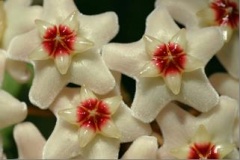Waxflower, Geraldton waxflower
| Infobox on Waxflower, Geraldton waxflower | |
|---|---|
| Example of Waxflower, Geraldton waxflower |  |
| Facts | |
| Origin | - |
| Stowage factor (in m3/t) | - |
| Humidity / moisture | - |
| Ventilation | - |
| Risk factors | See text |
Waxflower, Geraldton waxflower
Contents
Description / Shipment / Storage / Risk factors
Scientific Name and Introduction
Chamelaucium uncinatum. A native to Western Australia, the ‘Geraldton’ waxflower is available in shades of white through deep purple, and has become an important “filler” material. It is produced in substantial quantities in Israel and more recently in Australia and California. Various techniques have been developed to manipulate the flowering season, and the availability of substantial volumes from the Southern Hemisphere makes waxflower an item that is commonly available in the trade. The major postharvest problems are the shattering of flowers and petals, an ethylene-related problem that can be controlled by pre-treating the flowers with 1-MCP or STS, and Botrytis infection, particularly an issue for growing areas with erratic rainfall. Fungicide dips have successfully been used as a control measure. The specific epithet ‘uncinatum’ means hooked at the point, in reference to the leaves which are hooked at their ends. The crushed leaves give a pleasing citrus aroma.
Quality Characteristics and Criteria
Wax flowers are normally harvested with a mixture of open flowers and mature buds on each branchlet. Branches are harvested to maximize stem length without compromising the following year’s crop. Avoid buying if leaves or flowers have fallen off or are turning yellow.
Grading and Bunching
There are no grade standards for the flowers, which are sold in field bunches. Quality waxflowers have numerous flowers on long stems, and dark-green unblemished foliage. Waxflower bunches from Australia weigh 300 gr per bunch, whereas California bunches usually weigh 400 gr.
Ethylene Sensitivity
Waxflowers are very sensitive to ethylene, which causes loss of flowers, buds and leaves.
Pretreatments
Harvested wax flower bunches should be treated with 1-MCP or STS in the same way as carnations.
====Storage Conditions: Store waxflower at 0°C to 1ºC. If properly pre-cooled and subsequently wrapped in plastic to reduce water loss, flowers can be stored dry for up to 2 weeks at 1ºC. There is no benefit of wet over dry storage, and dry storage is therefore the method of choice. The main problem during storage is from growth of Botrytis on flowers. Dipping in 1% Rovral (Ipridione) solution prior to storage can prevent Botrytis infection.
Packing
Waxflowers are packed in bunches that contain variable numbers of stems (around 10) to provide a satisfactory bunch.
Special Considerations
The major storage problems are flower shatter (flowers fall off) and premature leaf yellowing and desiccation. Treat with anti-ethylene treatments like STS. Leaf yellowing cannot be controlled with STS or other commonly available preservatives.
Sources used
BMT De Beer’s Consolidated Manual on (Dutch) Flower Bulbs, cut flowers/greens and potted plants











